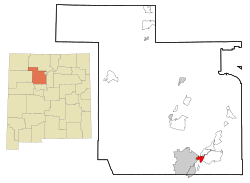Bernalillo, New Mexico
Bernalillo, New Mexico | |
|---|---|
 Bernalillo Town Hall | |
 Location of Bernalillo, New Mexico | |
| Country | United States |
| State | New Mexico |
| County | Sandoval |
| Area | |
| • Total | 4.7 sq mi (12.2 km2) |
| • Land | 4.6 sq mi (11.9 km2) |
| • Water | 0.1 sq mi (0.3 km2) |
| Elevation | 5,052 ft (1,540 m) |
| Population (2000) | |
| • Total | 6,611 |
| • Density | 1,436.9/sq mi (554.8/km2) |
| Time zone | UTC-7 (Mountain (MST)) |
| • Summer (DST) | UTC-6 (MDT) |
| ZIP code | 87004 |
| Area code | 505 |
| FIPS code | 35-06970 |
| GNIS feature ID | 0928691 |
Bernalillo is a town in Sandoval County, New Mexico, in the United States. As of the 2000 census, the town population was 6,611. It is the county seat of Sandoval County.[1]
Bernalillo is part of the Albuquerque Metropolitan Statistical Area.
Geography
Bernalillo is located at 35°18′34″N 106°33′7″W / 35.30944°N 106.55194°W (35.309363, -106.552032).[2] It lies in the Albuquerque Basin on the east bank of the Rio Grande. According to the United States Census Bureau, the town has a total area of 4.7 square miles (12 km2), of which, 4.6 square miles (12 km2) of it is land and 0.1 square miles (0.26 km2) of it (2.34%) is water.
Demographics
| Census | Pop. | Note | %± |
|---|---|---|---|
| 1880 | 1,223 | — | |
| 1950 | 1,922 | — | |
| 1960 | 2,574 | 33.9% | |
| 1970 | 2,016 | −21.7% | |
| 1980 | 2,988 | 48.2% | |
| 1990 | 5,960 | 99.5% | |
| 2000 | 6,611 | 10.9% | |
| 2010 | 8,320 | 25.9% | |
| 2015 (est.) | 8,843 | [3] | 6.3% |
As of the census[5] of 2000, there were 6,611 people, 2,309 households, and 1,724 families residing in the town. The population density was 1,436.9 people per square mile (554.9/km²). There were 2,473 housing units at an average density of 537.5 per square mile (207.6/km²). The racial makeup of the town was 60.17% White, 0.74% African American, 3.92% Native American, 0.20% Asian, 31.34% from other races, and 3.63% from two or more races. Hispanic or Latino of any race were 74.75% of the population.
There were 2,309 households out of which 40.8% had children under the age of 18 living with them, 49.1% were married couples living together, 18.6% had a female householder with no husband present, and 25.3% were non-families. 20.2% of all households were made up of individuals and 6.9% had someone living alone who was 65 years of age or older. The average household size was 2.86 and the average family size was 3.30.
In the town the population was spread out with 31.0% under the age of 18, 9.9% from 18 to 24, 28.5% from 25 to 44, 21.4% from 45 to 64, and 9.2% who were 65 years of age or older. The median age was 32 years. For every 100 females there were 93.9 males. For every 100 females age 18 and over, there were 91.4 males.
The median income for a household in the town was $30,864, and the median income for a family was $36,286. Males had a median income of $27,417 versus $22,125 for females. The per capita income for the town was $13,100. About 13.9% of families and 18.2% of the population were below the poverty line, including 25.4% of those under age 18 and 16.3% of those age 65 or over.
Cultural references
Bernalillo is mentioned several times in Willa Cather's 1927 novel Death Comes for the Archbishop.
Sam Shepard's play The Late Henry Moss is set "on the outskirts of" Bernalillo.
"The Padre of Isleta", Anton Docher first served as a priest in Bernalillo before his long time spent in Isleta.[6]
Bernalillo gallery
- widths="230px"
-
Historic Santuario de San Lorenzo, Bernalillo
-
Entrance, Santuario de San Lorenzo
References
- ^ "Find a County". National Association of Counties. Retrieved 2011-06-07.
- ^ "US Gazetteer files: 2010, 2000, and 1990". United States Census Bureau. 2011-02-12. Retrieved 2011-04-23.
- ^ "Annual Estimates of the Resident Population for Incorporated Places: April 1, 2010 to July 1, 2015". Retrieved July 2, 2016.
- ^ "Census of Population and Housing". Census.gov. Retrieved June 4, 2015.
- ^ "American FactFinder". United States Census Bureau. Retrieved 2008-01-31.
- ^ Leo Crane.Desert drums: the Pueblo Indians of New Mexico, 1540-1928.1972.Rio Grande Press




